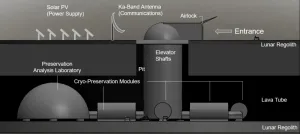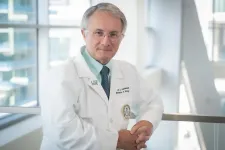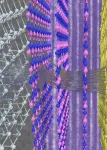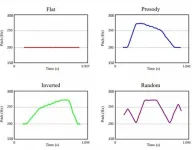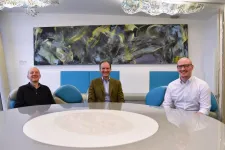(Press-News.org) University of Arizona researcher Jekan Thanga is taking scientific inspiration from an unlikely source: the biblical tale of Noah's Ark. Rather than two of every animal, however, his solar-powered ark on the moon would store cryogenically frozen seed, spore, sperm and egg samples from 6.7 million Earth species.
Thanga and a group of his undergraduate and graduate students outline the lunar ark concept, which they call a "modern global insurance policy," in a paper presented over the weekend during the IEEE Aerospace Conference.
"Earth is naturally a volatile environment," said Thanga, a professor of aerospace and mechanical engineering in the UArizona College of Engineering. "As humans, we had a close call about 75,000 years ago with the Toba supervolcanic eruption, which caused a 1,000-year cooling period and, according to some, aligns with an estimated drop in human diversity. Because human civilization has such a large footprint, if it were to collapse, that could have a negative cascading effect on the rest of the planet."
Climate change, he added, is another concern: If sea levels continue to rise, many dry places will go underwater - including the Svalbard Seedbank, a structure in Norway that holds hundreds of thousands of seed samples to protect against accidental loss of biodiversity. Thanga's team believes storing samples on another celestial body reduces the risk of biodiversity being lost if one event were to cause total annihilation of Earth.
Totally Tubular
Scientists discovered a network of about 200 lava tubes just beneath the moon's surface in 2013. These structures formed billions of years ago, when streams of lava melted their way through soft rock underground, forming underground caverns. On Earth, lava tubes are often similar in size to subway tunnels, and can be eroded by earthquakes, plate tectonics and other natural processes. This network of lunar lava tubes are about 100 meters in diameter. Untouched for an estimated 3 billion to 4 billion years, they could provide shelter from solar radiation, micrometeorites and surface temperature changes.
The idea of developing a lunar base, or human settlement on the moon, has been around for hundreds of years, and the lava tube discovery renewed the space community's enthusiasm for the concept. But the moon isn't exactly a hospitable environment where humans can spend extended periods. There isn't water or breathable air, and it's about minus 25 degrees Celsius, or minus 15 degrees Fahrenheit. It's also not a very eventful place.
On the other hand, those same features make it a great place to store samples that need to stay very cold and undisturbed for hundreds of years at a time.
Building a lunar ark is no small undertaking, but, based on some "quick, back-of-the-envelope calculations," Thanga said it's not as overwhelming as it may sound. Transporting about 50 samples from each of 6.7 million species would require about 250 rocket launches. It took 40 rocket launches to build the International Space Station.
"It's not crazy big," Thanga said. "We were a little bit surprised about that."
Cryogenics and Quantum Levitation
The mission concept builds on another project Thanga and his group previously proposed, in which miniature flying and hopping robots called SphereX enter a lava tube in teams. There, they would collect samples of regolith, or dust and loose rock, and gather information about the layout, temperature and makeup of the lava tubes. This information could inform the construction of the lunar base.
The team's model for the underground ark includes a set of solar panels on the moon's surface that would provide electricity. Two or more elevator shafts would lead down into the facility, where petri dishes would be housed in a series of cryogenic preservation modules. An additional goods elevator shaft would be used to transport construction material so that the base can be expanded inside the lava-tubes.
To be cryopreserved, the seeds must be cooled to minus 180 C (minus 292 F) and the stem cells kept at minus 196 C (minus 320 F). As a reference for just how cold this is, the Pfizer COVID-19 vaccine must be stored at minus 70 C, or minus 94 F. The fact that the lava tubes are so cold, and the samples must be even colder, means there's a risk the metal parts of the base could freeze, jam or even cold-weld together. On Earth, commercial airlines stop working when ground temperatures reach minus 45 to minus 50 C (minus 49 to minus 58 F).
However, there's a way to take advantage of the extreme temperatures by using an otherworldly phenomenon called quantum levitation. In this process, a cryo-cooled superconductor material - or a material that transfers energy without losing any heat, like a traditional cable does - floats above a powerful magnet. The two pieces are locked together at a fixed distance, so wherever the magnet goes, the superconductor follows.
"It's like they're locked in place by strings, but invisible strings," Thanga said. "When you get to cryogenic temperatures, strange things happen. Some of it just looks like magic but is based on tried and laboratory-tested physics principles at the edge of our understanding."
The team's ark design uses this phenomenon to make the shelves of samples float above metal surfaces and have robots navigate through the facility above magnetic tracks.
There is much more research to be done on how to build and operate the ark, from investigating how the preserved seeds might be affected by a lack of gravity to fleshing out a plan for base communications with Earth.
"What amazes me about projects like this is that they make me feel like we are getting closer to becoming a space civilization, and to a not-very-distant future where humankind will have bases on the moon and Mars," said Álvaro Díaz-Flores Caminero, a UArizona doctoral student leading the thermal analysis for the project. "Multidisciplinary projects are hard due to their complexity, but I think the same complexity is what makes them beautiful."
INFORMATION:
Neuroendocrine tumours are cancers that begin in specialised cells called neuroendocrine cells. These cells have traits similar to those of nerve cells and hormone-producing cells. Neuroendocrine tumours, while rare, can occur anywhere in the body. Most affect the cardiothoracic region, eg lungs, appendix, small intestine, pancreas as well as the rectum. There are many types of neuroendocrine tumours: some grow slowly while others develop very rapidly.
Neuroendocrine tumors are characterised by abundant production of somatostatin receptor 2, a naturally circulating hormone that is an important target for scientists studying new treatment approaches.
Peptide Receptor Radionuclide Therapy (PRRT) is the most commonly used treatment for refractive ...
Home delivery of HIV medicines in South Africa significantly increased viral suppression compared to those who received clinical care, according to a study by researchers at the University of Washington School of Medicine.
The study, conducted with Amazon.com guidance during COVID-19 restrictions in South Africa, showed that among study participants, paying a fee for home delivery and monitoring of antiretroviral therapy (ART) was highly acceptable in the context of low income and high unemployment, and improved health outcomes as a result.
The researching findings were ...
Researchers at the Buck Institute analyzed data from the COVID-19 Symptom Tracker app used by 3 million people in the United Kingdom, adding the use of immunosuppressant medication, use of a mobility aid, shortness of breath, fever, and fatigue to the list of symptoms and comorbidities that increase the risk for severe COVID-19. Results are published in the Journal of Medical Internet Research.
"Even though there are established risk factors for severe COVID-19 there are no good predictors that enable healthcare providers, or even those who have tested positive, to assess who should seek advanced medical care," says Buck Institute ...
TAMPA, Fla. (March 8, 2021) -- Preterm birth is a END ...
Recently, Prof. CHEN Gao from Institute of Geometry and Physics of the University of Science and Technology of China has made breakthrough in the field of complex differential geometry. Using mathematical invention, he buildt a new bridge between the relativity of Einstein and quantum mechanics. This work was published in Inventiones Mathematicae.
In the field of complex differential geometry, there are two crucial physical equations: the Hermitian-Yang-Mills equation, which became the standard model of quantum mechanics, and the Kähler-Einstein equation, which is closely related to relativity. To stably solve these two equations ...
A team of researchers led by Professor Yaakov Nahmias, director of the Grass Center for Bioengineering at the Hebrew University of Jerusalem and founder of Tissue Dynamic, introduced a new technological approach that has the potential to rapidly develop new drugs without the need for animal experiments.
According to Professor Nahmias, "Drug development is a long and expensive endeavor that is defined by multiple failures. The main reason for this failure is that clinical experiments are ultimately based on minimal information gained from animal experiment which often fail to replicate the human response."
The primary animals used in drug development ...
For decades, there has been a trend in microelectronics towards ever smaller and more compact transistors. 2D materials such as graphene are seen as a beacon of hope here: they are the thinnest material layers that can possibly exist, consisting of only one or a few atomic layers. Nevertheless, they can conduct electrical currents - conventional silicon technology, on the other hand, no longer works properly if the layers become too thin.
However, such materials are not used in a vacuum; they have to be combined with suitable insulators - in order to seal them off from unwanted environmental influences, and ...
Prosody is a branch of linguistics that analyses and formally represents the elements of oral expression such as pitch, tones and intonation. A study published in Cognition on 5 February shows that there are universal prosodic cues that help with learning in humans and in animals.
This study, published by Juan Manuel Toro, ICREA research professor and Paola Crespo-Bojorque, researchers of the Center for Brain and Cognition (CBC) of the UPF Department of Information and Communication Technologies (DTIC), is part of the research into language evolution that is being conducted thanks to a European Research Council Starting Grant.
Some of the mechanisms we humans use to learn language are based on general principles ...
Long life is common among bird parents that get help with childcare. This finding comes from researchers at the universities of Lund and Oxford who reviewed data from more than 9,000 studies.
Being a parent can be tough. In general, animals that care for many offspring die young, at least in species where parents are not helped by others. However, in some species things are different and parents recruit 'helpers' to assist with childcare. In such group-living species, parents often produce lots of young and also live an exceptionally long time. This new research ...
Thrombotic occlusion of blood vessels, which leads to myocardial infarctions, strokes and venous thromboembolisms, is the major cause of death in the western hemisphere. Therefore, it is of critical importance to understand mechanisms preventing thrombus formation. A new study by the research group of Christoph Binder, Principal Investigator at the CeMM Research Center for Molecular Medicine of the Austrian Academy of Sciences and Professor at the Medical University of Vienna, now explains the important role of immunoglobulin-M (IgM) antibodies in preventing thrombosis. The study published in the journal Blood shows that these antibodies recognize microvesicles, which are ...
